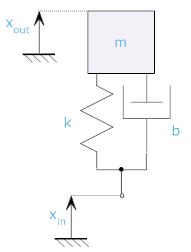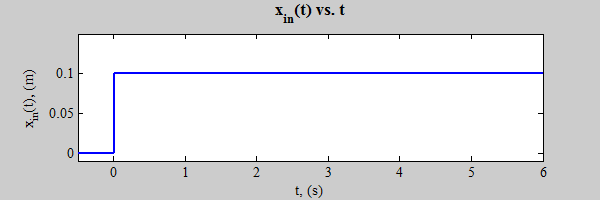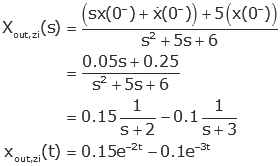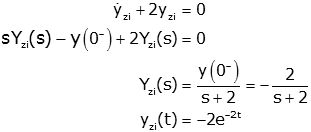

Contents
Before starting this section make sure you understand how to create a transfer function representation of a system.
Zero input and zero state solutions of a system can be found if the transfer function is known, though the transfer function is more commonly used for the zero state response. We will first develop the transfer function for a system, and then solve for the zero state and zero input solutions.
The system shown is a simplified model of a part of a suspension system of a wheel on a car or motorcyle. The mass, m, represents the weight of the vehicle supported by the wheel, and the spring and dashpot represent the suspension system. For our purposes let m=500 kg, k=3000 N/m, b=2500 N-m/s.


Let us first find the transfer function of this system:

The standard form has the coefficient of the highest order of "s" in the denominator equal to one.

What is the zero state response of the system if the input is as shown; xin(t)=0.1·γ(t)? This might represent a curb 10 cm high.

To find the output, we multiply the transfer function by the input, and solve.

We can find the inverse Laplace Transform by performing a partial fraction expansion to get the solution into forms that are in the table.


In the Laplace domain we use the Transfer Function to find the zero state response by simply multiplying the Laplace Transform of the input function by the Transfer Function. Since multiplication in the Laplace domain is equivalent to convolution in the time domain, this means that we can find the zero state response by convolving the input function by the inverse Laplace Transform of the Transfer Function. In other words, if

and

then

A discussion of the evaluation of the convolution is elsewhere.
From the equations above we can also see that if x(t)=δ(t)=unit impulse, then X(s)=1, and Yzs(s)=H(s), so yzs(t)=h(t). In other words, the impulse response of the system is simply the inverse Laplace Transform of the Transfer Function. This means that if we can find the impulse response of the system, we immediately know the transfer function (and the system differential equation...). Knowing the impulse response gives us complete information about the system.
Given the transfer function of a system:

The zero state response is easily found

Note: h(t)=system impulse response and in the time domain yzs(t)=h(t)*x(t).
What is the zero input response of the system starts at rest (the velocity is zero) but xout(0-)=0.05? This might represent lifting up on the car by 5 cm and then releasing at t=0.
In this case we will use the transfer function to determine the system differential equation

Now we set Xin(s) to zero, and write the differential equation

Note: we could have skipped the first steps and immediately write the differential equation using the coefficients of the denominator polynomial as the coefficients of the differential equation (with order of polynomial equal to order of differentiation).
We now take the Laplace Transform, without setting initial conditions to zero

and solve for the output

In general if we have a transfer function of the form

then the zero input solution is given by

To demonstrate this we start from the transfer function, and then write the Laplace Domain form of the differential equation

Set the input to zero, and then take the inverse Laplace Transform to find the original zero input form of the differential. The first equation below shows the zero-input differential equation in the Laplace domain, the second equation shows the zero-input differential equation in the time domain. In the time domain equation the (n-i) term above the y denotes a derivative of order (n-i)..

Take the Laplace Transform, but this time include the initial conditions (using the differentiation property of the Laplace Transform)

and solve for Y(s)

Given the transfer function of a system:

The zero input response is found by first finding the system differential equation (with the input equal to zero), and then applying initial conditions.
For example if the transfer function is

then the system differential equation (with zero input) is

and the Laplace Transform (with initial conditions) is

or

Now consider the situation when xout(0-)=0.05 and xin(t)=0.1·γ(t). What is the output?
We have already determined the zero input response to the initial condition, and the zero state response to the input, so the complete response is simply the sum of the zero input and zero stat response.

If either the initial condition or the input is changed, we would need to recalculate either the zero input or zero state part of the solution. The complete response would then be found by adding the new zero input and zero state solutions.
Find the zero state and zero input response of the system

with

Solution:
1) First find the zero state solution.

Take the inverse Laplace Transform:

2) Now, find the zero input solution:

3) The complete response is just the sum of the zero state and zero input response


Note that the complete response converges to the zero state response at long times as the zero input response decays to zero.
To find the complete response of a system from its transfer function:



© Copyright 2005 to 2019 Erik Cheever This page may be freely used for educational purposes.
Erik Cheever Department of Engineering Swarthmore College